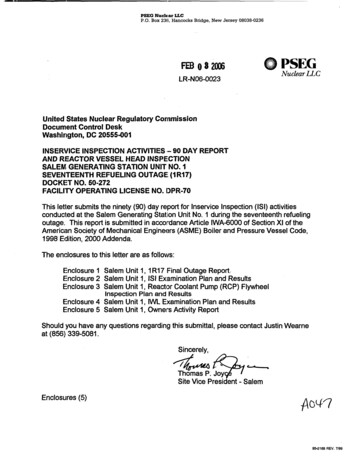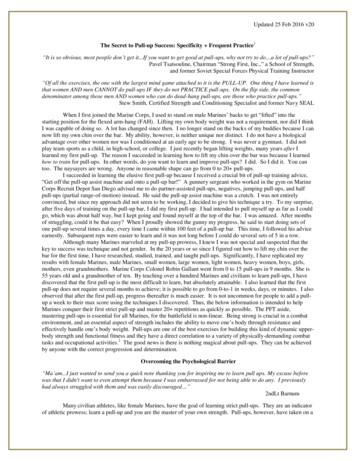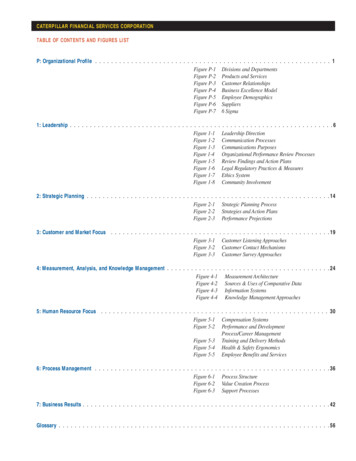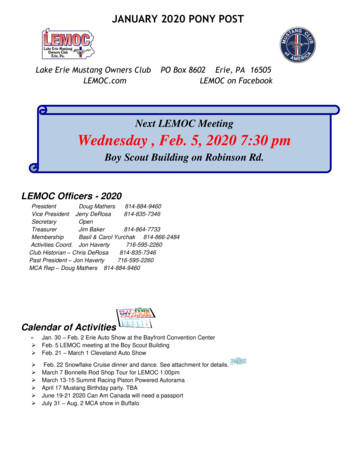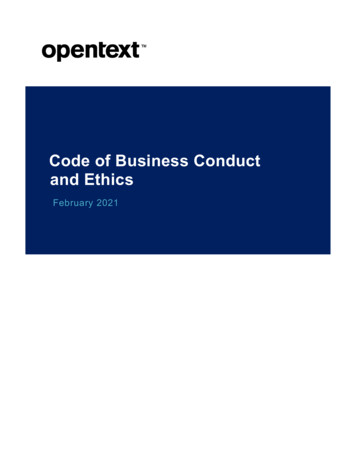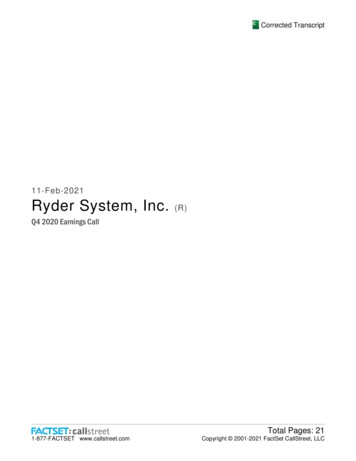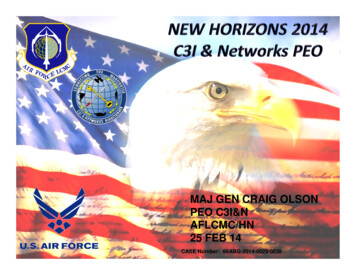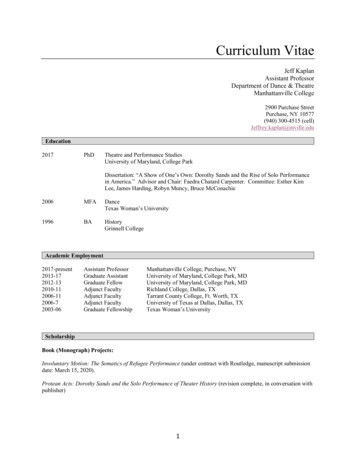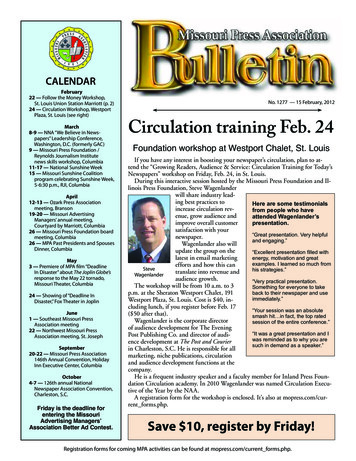
Transcription
TEACHERS OF ENGLISH AS A SECOND LANGUAGE OF ONTARIOVol. 37 No. 1Feb 2011Contact is published three timesa year by Teachers of Englishas a Second Language of Ontario.ISSN 0227-2938From the Editor 3Photo Gallery: 6TESL Ontario ConferenceIMMIGRATION ANDSETTLEMENTCulture Shock 8By Melissa Pedersen andMaria BrzeskaTESL Ontario Conference 2010:‘Research and Teaching: ACollaborative Process’IN THE CLASSROOMUsing Short Stories 13By Shaheen MerajBringing Canadian 22Culture into the ESLCurriculumBy Lori Potolicki SteersTEACHING WITHTECHNOLOGYDigital Materials 25Preparation for TESOLProfessionalsBy John Allanand Stephen RoneyWhat Can Resistance to 32Technology Teach Us?By Douglas OrmeCREATIVE WRITINGEnglish Lessons 36By Judy Pollard SmithINTERVIEWEnglish is Stupid, 38According to AuthorJudy ThompsonBy Kathleen JacksonBOOK REVIEWJust a Phrase I’m 42Going ThroughReview by Tania PattisonRESEARCHAnalysis of Research 45Article IntroductionsBy Pejman HabibieBy Tania PattisonThe TESL Ontario annual conferenceis undoubtedly the best opportunityto learn about innovative classroomactivities, network with fellow professionals and share ideas, explore new teaching materials, discover the results of cutting-edge research, and just enjoy beingpart of the vibrant TESL Ontario community.It’s an event many of us look forward to all year, and the 38th Annual TESLOntario 2010 Conference, held in Octo-ber at the Sheraton Centre in Toronto,did not disappoint.The conference attracted 1615 participants from all regions of Ontarioand all branches of ESL. The Sheratonprovided an ideal setting to catch upwith old friends and make new ones.The 2010 conference program featured 295 sessions, on a variety of topics: classroom techniques, research re(Continued on page 5)
Page 2TEACHERS OF ENGLISH AS A SECOND LANGUAGE OF ONTARIOContact usContact welcomes articles of generalinterest to association members, including announcements, reports, articles, calls for papers, and news items.Contributors should include their fullname, a brief biographical statement and, ifthey wish, a photograph. Submissions shouldbe emailed to editor@teslontario.org ortania.tesl@gmail.com. Deadlines are April30, Aug. 31, and Dec. 31.TESL Ontario’s phone number is (416)593-4243, and the fax number is (416) 5930164. The website is www.teslontario.org.Enquiries regarding membership orchange of address should be addressed tothe TESL Ontario Membership Coordinator atmembership@teslontario.org.Enquiries regarding advertising ratesand reservation of advertising space shouldbe addressed to the Office Coordinator atadministration@teslontario.org.The statements made and expressedin articles are those of the authors and do notnecessarily reflect the policies of TESL Ontario.Acceptance of advertising does notconstitute endorsement by TESL Ontario norguarantee accuracy of information therein.About copyrightOccasionally, writers of articles published in Contact would like to havetheir work reprinted elsewhere(e.g., in another magazine or journal). TESLOntario’s policy on reprinting Contact articles is as follows:Copyright for all articles published inContact rests with TESL Ontario. Any reprintselsewhere require the written permission ofTESL Ontario. In addition, the reprinted article must clearly state that the work was originally published in TESL OntarioContact aswell as the original date of publication.By agreeing to have his/her workpublished in Contact, the author thereby acknowledges understanding of, and agreement with, this policy.Permission to have a Contact articlereprinted may be requested from TESL Ontario’s Executive Director, Renate Tilson(rtilson@teslontario.org).
Contactvolume 37, issue 1Page 3From the EditorWelcome to the first issue of Contact,2011, and my first as editor. I amthrilled to be taking over as editor,and I look forward to working with many of you.The theme of this issue is the TESL Ontario conference, held in October, 2010 in Toronto. In the first of several articles based onpresentations at the TESL Ontario conference,October 2010, Melissa Pedersen and MariaBrzeska outline the cultural challenges experienced by newcomers to Canada, and offersome suggestions to teachers dealing withthese issues in their classrooms.Next, we turn our attention to teachingmethods and techniques, both inside and outside the classroom. Shaheen Meraj, also a conference presenter, shows how literature has aplace in the classroom, not only for EAP learners, but also for LINC students and students ofgeneral ESL. Lori Potolicki Steers then explores the world of experiential learning, sharing with Contact readers a course she developed to show students what makes Canadaunique. In Lori’s course, students leave theclassroom and learn about Canada through activities such as canoeing and snowshoeing.The next two articles deal with the useof technology in ESL. John Allen and StephenRoney, conference presenters and regular contributors to Contact, describe an online coursedesigned to introduce ESL teachers to Web 2.0tools they can use for materials development.Douglas Orme follows up on my own review ofMeddings and Thornbury’s Teaching Unplugged(published in Contact, Vol. 36, No. 3) and questions why teachers show resistance to usingtechnology in the classroom.There is no doubt that there is a greatdeal of creativity among TESL Ontario members! Judy Pollard Smith is one example of anESL teacher who is also a writer; her poem English Lessons was inspired by her work with Vietnamese immigrants.Tania PattisonIs English stupid? Judy Thompson, oneof the publishers present at the conference,thinks so; she has published a book that tells usexactly how stupid it is, and why. KathleenJackson’s interview with Judy explores the theory behind Judy’s work and offers insight intohow best to teach speaking skills to ESL learners.The genius of David Crystal, guru of theEnglish language, is revealed not only in theclever title of his autobiography—Just a PhraseI’m Going through: My Life in Language, but inthe pages of the book itself. My admiration ofCrystal’s work made this book a must-read forme, and I’m happy to share it with you.Our final piece is a report of anotherTESL Ontario 2010 conference presentation.True to the theme of the conference, ‘Researchand Teaching: A Collaborative Process’, PejmanHabibie reports on his investigation into genreanalysis involving three research papers written in three branches of linguistics.I would like to thank each of these writers for submitting their work to Contact, and Iwould like to conclude with an invitation (Continued on page 4)
TEACHERS OF ENGLISH AS A SECOND LANGUAGE OF ONTARIOPage 4(Continued from page 3)Write for Contact!I am eager to receive articles of interest to TESLOntario members. Whether you are an experienced writer or someone who has never published before, please consider writing for Contact. Some possible themes are as follows: Teaching methods, techniques, andactivities. Do you have a classroomactivity that works, and that you wouldlike to share? Have you experimentedwith a new approach to teaching?Would you like to share your insightsinto teaching with technology, experiential learning, evaluation, or anyother approach to ESL instruction? I’dlove to hear from you. Issues related to settlement and immigration. Do your own experiencesprovide you with insights that youwould like to share with Contact readers? Do you have advice for teachersengaged in teaching newcomers, orstrong feelings about issues related toimmigration and settlement? Pleaseconsider sharing these. Research. While Contact is not a peerreviewed journal, you are certainlyinvited to submit the results of yourresearch for publication in Contact. Creative writing. Do you, like JudyPollard Smith in this issue, have a creative flair? Send me your poems andshort stories related to the ESL teaching profession! Book reviews. Anyone interested inreviewing books related to ESL instruction is invited to get in touch. Youmay choose to review a book that hascaught your attention—as I did withDavid Crystal’s book-—or I can alsooffer suggestions. Letters to the editor. Would you liketo comment on anything you haveread in Contact? Drop me a line! Other topics of interest to the TESLOntario community. Contact is yourmagazine; if you have a topic close toyour heart, and that you think wouldbe interesting and relevant to the TESLOntario community, please share yourthoughts.Whether you have a specific idea for an article,or if you just want to chat about future involvement with Contact, please get in touch.The best way to reach me is by e-mailat tania.tesl@gmail.com. I am looking forward to hearing from you!-Tania
Contactvolume 37, issue 1Page 5TESL Ontario conference (cont’d)It was back to school for some participants at the 2010 TESL Ontario conference(Continued from page 1)sults, materials, technology, testing, and muchmore. Plenary speakers included Dr. Bonny Norton, Dr. Ken Beatty, and Dr. Jim Cummins. In thePanel Discussion, representatives of Ontario’sMinistries of Education; Citizenship and Immigration; and Training, Colleges and Universitiesaddressed the audience.Also, the annual Research Symposia generated much interest, as did the annual TechnologyFair.In a new addition to the conference, posterpresentations made their debut in 2010. Handouts from many of the presentations are available on the TESL Ontario website (http://www.teslon.org/handouts2010/) and proceedings of the Research Symposia will be publishedin a separate volume.A total of 53 exhibitors were present atthe conference, including publishers, testingproviders, and those promoting other servicesand products of interest to our community.The Friday night gala dinner at theSheraton featured speeches from the Hon. EricHoskins, Ontario Minster of Citizenship and Immigration and Heidi Jurisic from Citizenship andImmigration Canada, both affirming their commitment to the ESL profession in Ontario.Also on Friday night came the announcement that TESOL 2015 will be held in Toronto.Our photo gallery of from the conference is online at http://www.teslon.org/confpics2010/, but we’ve selected a few to publish in Contact.
Page 6TEACHERS OF ENGLISH AS A SECOND LANGUAGE OF ONTARIOTESL Ontario 2010 ConferencePhoto Gallery
Contactvolume 37, issue 1Page 7
TEACHERS OF ENGLISH AS A SECOND LANGUAGE OF ONTARIOPage 8IMMIGRATION AND SETTLEMENTCulture ShockBy Melissa Pedersen with Maria BrzeskaThe change relatedto moving from oneculture into anotheris profound if it’sperceived to belong-term orpermanent.Parminder1 arrived in Canada from India’sPunjab region in the middle of winter. Thenext day when she awoke and lookedthrough the window, there was a thick layer ofsnow covering everything around.From her sister’s house located in a residential suburb, Parminder could not see anyonewalking on the street. She detected no domesticactivities, no children playing, and no noisewhatsoever. It was a shocking difference fromthe community life in Punjab where so manythings were done outdoors, where everyoneknew each other and their family members(even the distant ones), where people had mutual friends, and where the whole communitycelebrated holidays together. Her new environment felt like a white desert, cold and unfriendly.She felt totally isolated and lonely. She remembers staying at that window and crying, tearsfalling down her cheeks, longing for the life andthe people back in Punjab that she could notimagine missing so much.Parminder experienced the disorientation of culture shock from her first day in Canada. She eventually realized that her Canadianlife also had good sides: freedom to make herown decisions, freedom from having every action scrutinized by society, freedom from conformity, the ability to work in her chosen profession, chances to attend courses and developskills but it took time for her to recover fromthe shock.1. Parminder’s story and those others referenced in this article are real and used with permission.(Continued on page 9)
Contactvolume 37, issue 1Page 9brought to the table at the end ofthe meal, because in his culturewhat came in a bowl was soup.(Continued from page 8)What is culture shock?Culture shock2 refers to the physical and emotional reaction to sudden immersion into a newenvironment where one is not certain about expectations and what is or is not appropriate behaviour in formerly familiar situations. All changeengenders shock of some kind. Usually, but notalways, if you are the one who decides to makethe change, the transition is easier. But thechange related to moving from one culture intoanother, particularly if this change is perceivedto be long term or permanent, is profound. Cognitive fatigue stems fromhaving to learn so many newcues, as well as a new language.One Friday afternoon, one of myLINC students put her hands overher ears and said, “I just can’tlisten to any more English today!” Unfamiliar body language cancause lack of understanding orinappropriate responses in socialsituations. As an uncertain newdriver, Maria made a road errorwhich caused another driver tomake a lewd gesture to her. Notknowing the meaning, she pleasantly waved back to him and reported to her friends how friendlyCanadian drivers were! Manners may be different andfamiliar behaviours don’t work orreceive unexpected responses.What is acceptable in one’s country may be considered rude inCanada and vice versa. Somephrases don’t mean what theysay. When Canadians say “Howare you?” or “How are you doing?” they don’t really want toknow! Role and personal change canbe huge. Economic needs mayreverse financial support rolesresulting in diminishing the former breadwinner. Children maylearn English faster and becometranslators and voices for theirparents. The inability to work in afield or enter a career that waspart of the newcomer’s identitycan be a very difficult loss. WhenI came to Canada myself, Ilearned that Ontario did not rec
a year by Teachers of English as a Second Language of Ontario. ber at the Sheraton Centre in Toronto, did not disappoint. The conference attracted 1615 par-ticipants from all regions of Ontario and all branches of ESL. The Sheraton provided an ideal setting to catch up with old friends and make new ones. The 2010 conference program fea-
